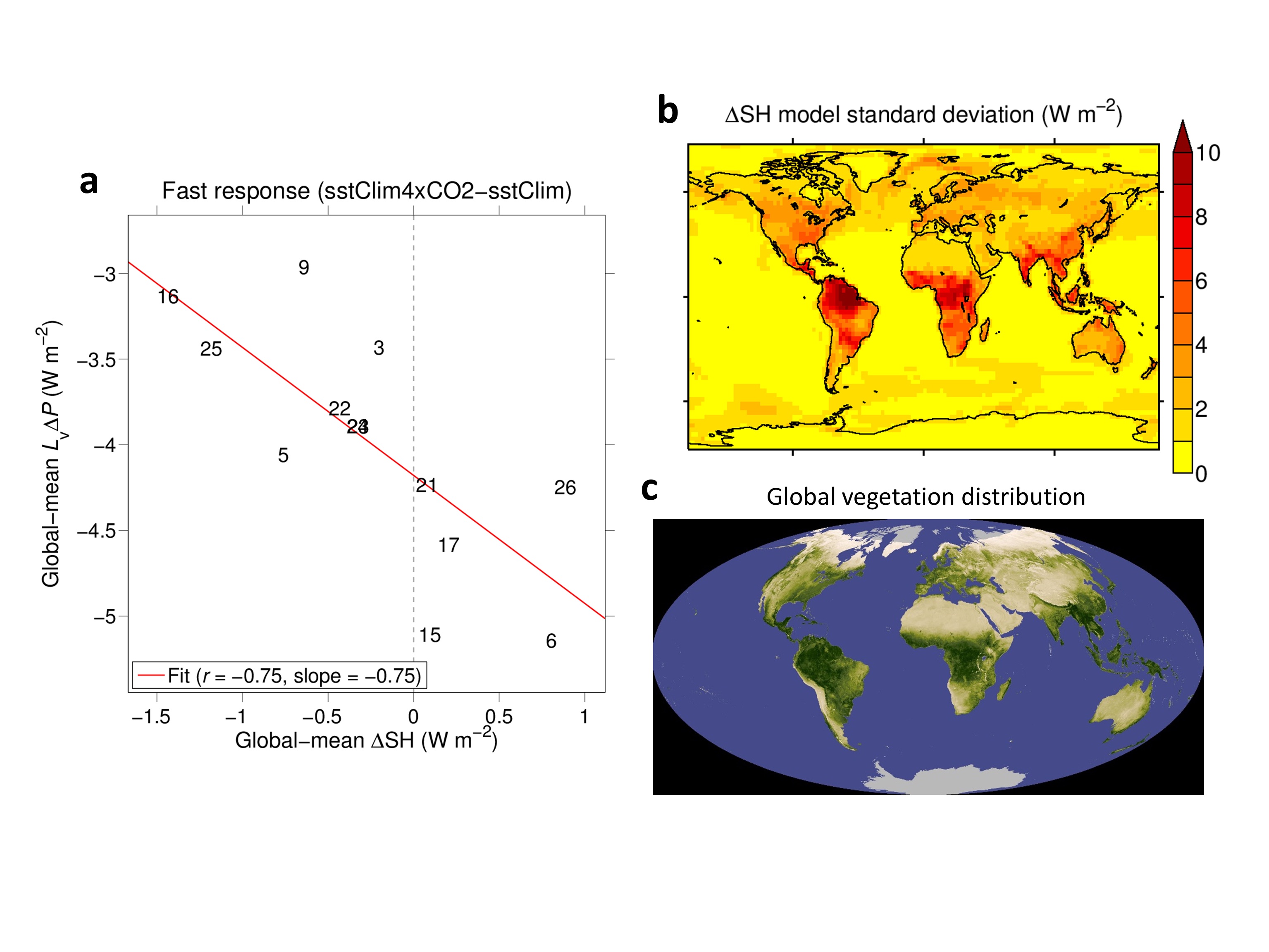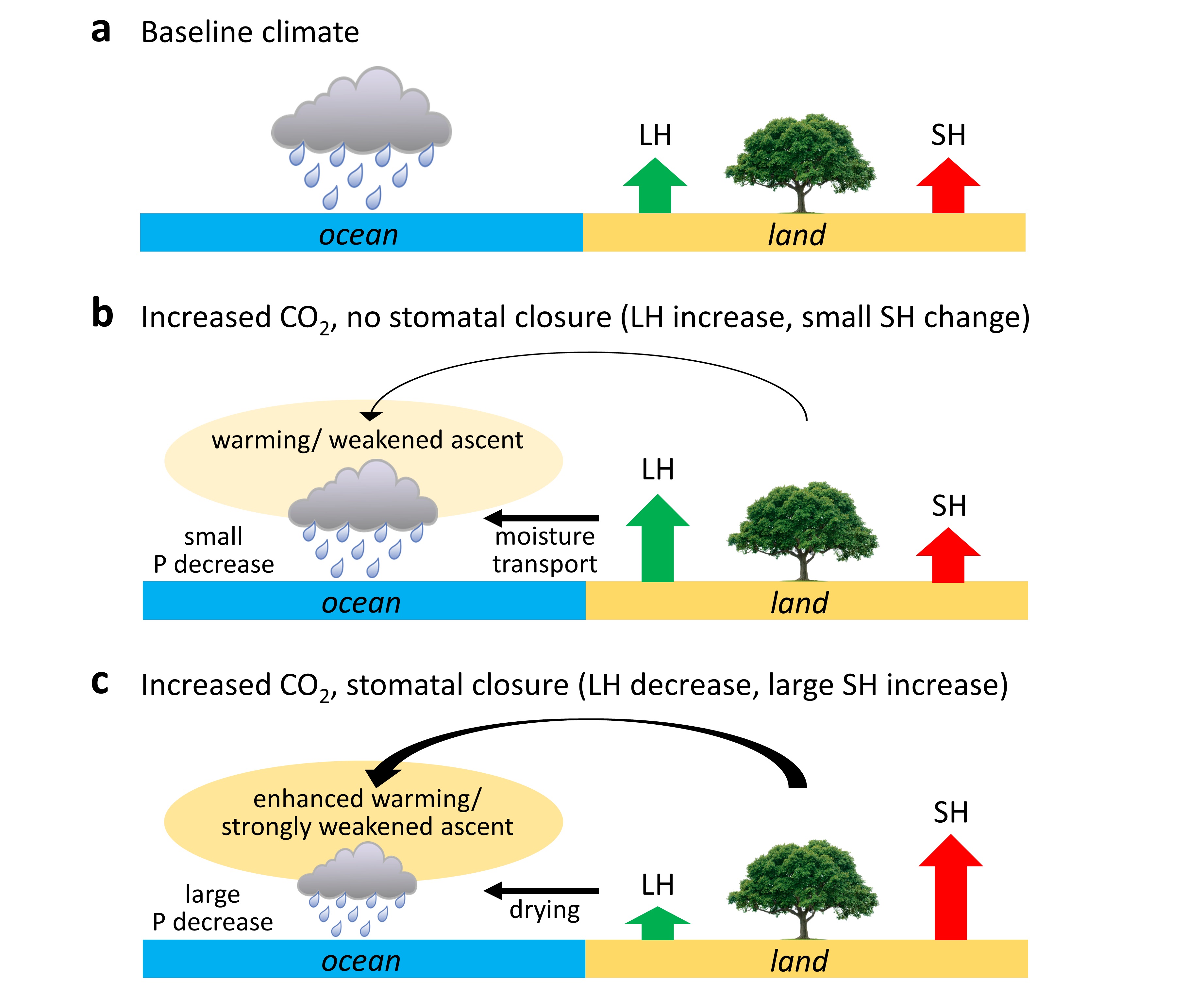
|
||||||||||||||||
|

Climate Feedbacks and Emergent Constraints Importance of vegetation processes for model spread in the fast precipitation response to CO2 forcingIn the current generation of climate models, the projected increase in global precipitation over the 21st century ranges from 2% to 10% under a high-emission scenario. Some of this uncertainty can be traced to the rapid response of precipitation to carbon dioxide (CO2) forcing. When CO2 increases, the land and atmosphere adjust on a timescale much shorter than that of the ocean, causing a decrease in global precipitation prior to a subsequent increase that is driven primarily by slow oceanic warming. Specifically, atmospheric longwave cooling becomes suppressed and there is a net downward radiative perturbation over land. This causes rapid atmospheric and land warming, both of which act to increase atmospheric stability over important oceanic convective regions, decreasing precipitation there (and also globally averaged). While a rapid decrease in global precipitation is robust among models, its magnitude varies by a factor of two. Variability in this fast response of precipitation contributes to the model differences in the projected end-of-21st-century total increase in global precipitation. It is thus important to understand what is causing the spread in the fast precipitation decrease. We analyzed output from 26 models participating in the Coupled Model Intercomparison Project Phase 5 (CMIP5) to understand model variability in the fast precipitation response. A substantial amount of the variability can be traced to how the land surface partitions a change in sensible versus latent heat flux in response to the CO2-induced radiative perturbation. In models with a large sensible heat flux increase over land, global-mean precipitation decreases by more (Figure 1a). Model differences in the land heat flux response are largest over densely vegetated regions, hinting that vegetation processes are important for the model spread (Figures 1b,c). To further investigate this, we compared simulations in which vegetation responses to CO2 were active or inactive. Model variability in the land heat flux response is suppressed substantially in the case where vegetation does not respond to CO2, supporting that vegetation processes are behind much of the model spread (see paper for more details).  Figure 1: (Click to enlarge.) (a) Comparison of the fast response of global-mean precipitation (LvΔP, ordinate) with that of global-mean sensible heat flux (ΔSH, abscissa) across models. Numbers refer to different models. A linear fit to the scatterplot is shown as the red line, with correlation (r) and slope given in the legend. Fast responses are computed as the difference in mean climate between simulations in which atmospheric carbon dioxide is quadrupled and held at its pre-industrial levels and sea surface temperatures are fixed. (b) The cross-model standard deviation in ΔSH computed at each grid cell. (c) The distribution of vegetation across the planet, with darker green indicating denser vegetation (from https://www.nasa.gov/multimedia/imagegallery/image_feature_1056.html) A main reason for the difference in the land heat flux response to CO2 is that some models include a process in which leaf stomata close when CO2 increases, while others do not. In models that include this process, latent heat flux decreases and sensible heat flux increases. Global precipitation decreases by more in these models because the extra added heat from land stabilizes the atmosphere and suppresses ascent more in important oceanic convective regions. Furthermore, the decrease in evaporation over land dries the atmosphere and further suppresses precipitation over the ocean. In models that omit this process, latent heat flux increases and sensible heat flux changes little over land, resulting in a smaller reduction in global precipitation (see schematic in Figure 2). Among models that include stomatal closure, there is substantial spread in the land heat flux response (not shown), suggesting that different vegetation parameterizations may also play an important role in the model variability. An extensive evaluation of vegetation responses to CO2 against observations is thus an important next step in constraining the fast response of land heat fluxes and global precipitation to CO2 forcing.  Figure 2:
(Click to enlarge.) Schematic depicting the link between
stomatal closure, land heat fluxes, and the fast response of
precipitation. (a) The baseline climate. LH and SH over land
are similar in magnitude. (b) Increased CO2 with fixed SST
in the case of no stomatal closure. The atmosphere warms due
largely to suppressed longwave cooling from increased CO2.
The land-sea warming contrast drives an anomalous
circulation from land to ocean depicted by the curved arrow,
enhancing oceanic atmospheric warming and suppressing
ascent. These processes act to decrease precipitation over
oceanic convective regions. Over land, LH increases and SH
changes little. The mean circulation transports this land
atmospheric moisture increase to the ocean, helping to
mitigate the oceanic precipitation decrease. (c) Increased
CO2 in the case of stomatal closure. The anomalous land to
ocean circulation (curved arrow) is stronger due to a large
increase in SH, resulting in greater atmospheric warming and
suppressed ascent over the ocean than in the case with no
stomatal closure (panel b). Furthermore, the land to ocean
mean circulation dries the atmosphere over ocean due to
decreased LH over land. The result is a larger decrease in
oceanic convective precipitation. Note that LH and SH flux
arrows are not drawn exactly to scale.
Figure 2:
(Click to enlarge.) Schematic depicting the link between
stomatal closure, land heat fluxes, and the fast response of
precipitation. (a) The baseline climate. LH and SH over land
are similar in magnitude. (b) Increased CO2 with fixed SST
in the case of no stomatal closure. The atmosphere warms due
largely to suppressed longwave cooling from increased CO2.
The land-sea warming contrast drives an anomalous
circulation from land to ocean depicted by the curved arrow,
enhancing oceanic atmospheric warming and suppressing
ascent. These processes act to decrease precipitation over
oceanic convective regions. Over land, LH increases and SH
changes little. The mean circulation transports this land
atmospheric moisture increase to the ocean, helping to
mitigate the oceanic precipitation decrease. (c) Increased
CO2 in the case of stomatal closure. The anomalous land to
ocean circulation (curved arrow) is stronger due to a large
increase in SH, resulting in greater atmospheric warming and
suppressed ascent over the ocean than in the case with no
stomatal closure (panel b). Furthermore, the land to ocean
mean circulation dries the atmosphere over ocean due to
decreased LH over land. The result is a larger decrease in
oceanic convective precipitation. Note that LH and SH flux
arrows are not drawn exactly to scale.
Download the publication (DeAngelis et al. 2016) describing these results in more detail. This study was conducted as part of a joint project between UCLA and Lawrence Livermore National Laboratory, funded by the US Department of Energy. Learn more about our group's research
|
|||||||||||||||
